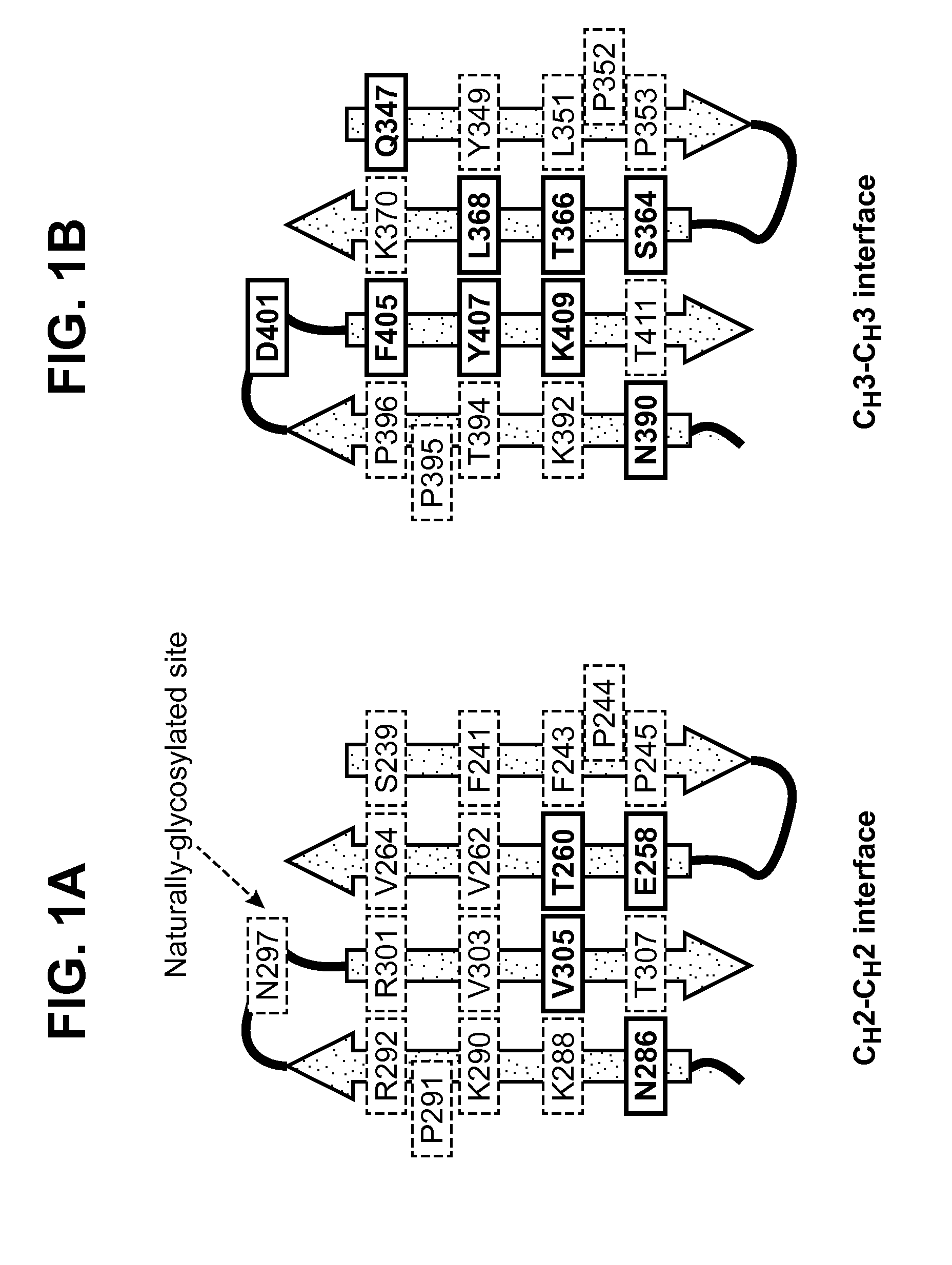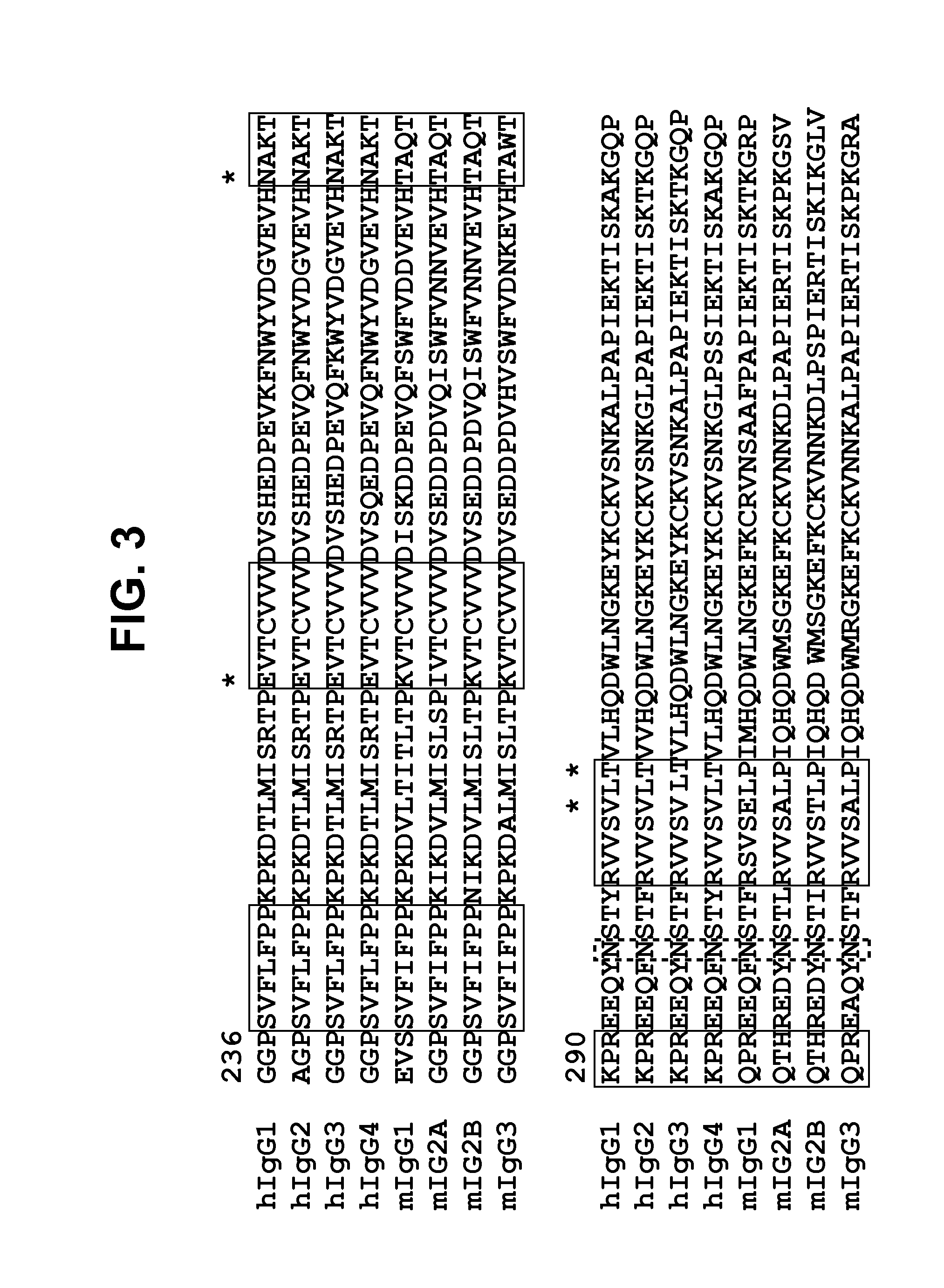Engineered monomeric antibody fragments
a monomeric antibody and fragment technology, applied in the field of engineered monomeric antibody fragments, can solve the problems of unwanted agonist activity, poor penetration of full-size iggs into tissues, and not always necessary or desired bivalency of iggs
- Summary
- Abstract
- Description
- Claims
- Application Information
AI Technical Summary
Benefits of technology
Problems solved by technology
Method used
Image
Examples
example 1
Monomerizing an Otherwise Dimeric Fc by Incorporating N-Glycosylation Sites in the CH3-CH3 Interface
[0120]A glycoengineering strategy was used to engineer a stable monomeric form of an Fc domain of an antibody. More specifically, bulky and hydrophilic carbohydrate moieties were introduced in the CH3-CH3 interface, which separated the dimer form of Fc into a monomeric form. Surprisingly, this glycoengineering also stabilized the exposed interface of CH3 domain. Four criteria were employed to determine where to incorporate N-glycosylation mutational sites (to provide the canonical N-linked glycosylation signal sequence of Asn-X-Ser / Thr). First, residues located on the interface of CH3-CH3 were identified, so as to avoid selecting the residues buried in the Ig domain core or the residues exposed to the solvent (FIG. 1). The crystal structure of human gamma1 Fc (PDB ID: 1HZH) was used to calculate the percent accessible surface (% ASA) of each residue in both Fc dimer (native form) and ...
example 2
Characterization of N-Glycosylation Variants
[0121]Four mutants (positions 364, 368, 405 and 407) with complete N-glycosylation were selected for further purification and characterization. These N-glycosylation mutants, denoted as CH23-N364 (Fc-S364N), CH23-N368 (Fc-L368N / K370T), CH23-N405 (Fc-F405N / Y407T) and CH23-N407 (Fc-Y407N / K409T), were purified as described elsewhere herein, resulting in >95% purity as judged by SDS-PAGE. The yields of purified protein were in the range of 20-30 mg per liter of media. In order to assess relative yields of glycosylated and non-glycosylated variants at each position, capillary gel electrophoresis (CGE) assay of purified protein without and with treatment of PNGase F was carried out. The data disclosed herein suggest that these four mutants contain up to 10% non-glycosylated variants, which is similar to wild type Fc (Table 2). Analytical size exclusion column (SEC) was used to estimate the apparent molecular weights of N-glycosylation variants. ...
example 3
Combination of Multiple N-Glycosylation Sites
[0122]To further minimize the non-glycosylated portion for each variant, two N-glycosylation sites in CH3 domain were introduced through individual mutations at positions of 364, 368, 405 and 407, which resulted in 90% to 95% occupancy of glycosylation. FIG. 3 highlights the special alignment of Ser364, Leu368, Phe405 and Tyr407 in the interface of CH3 domain. Based on these observations, it was hypothesized that two carbohydrate moieties at two sites among 368, 405 and 407 would further destabilize the structure because these three residues are located in close proximity to each other. Therefore, three combinations of these N-linked sites, i.e., N364 and N368, N364 and N405 and N364 and N407, were selected for the incorporation of two N-glycosylation sites. These three double N-glycosylation mutants, namely CH23-N364 / N368, CH23-N364 / N405 and CH23-N364 / N407, were expressed in HEK293 cells and were examined for expression and glycosylation...
PUM
| Property | Measurement | Unit |
|---|---|---|
| molecular weight | aaaaa | aaaaa |
| molecular weight | aaaaa | aaaaa |
| apparent molecular weight | aaaaa | aaaaa |
Abstract
Description
Claims
Application Information
 Login to View More
Login to View More - R&D
- Intellectual Property
- Life Sciences
- Materials
- Tech Scout
- Unparalleled Data Quality
- Higher Quality Content
- 60% Fewer Hallucinations
Browse by: Latest US Patents, China's latest patents, Technical Efficacy Thesaurus, Application Domain, Technology Topic, Popular Technical Reports.
© 2025 PatSnap. All rights reserved.Legal|Privacy policy|Modern Slavery Act Transparency Statement|Sitemap|About US| Contact US: help@patsnap.com



